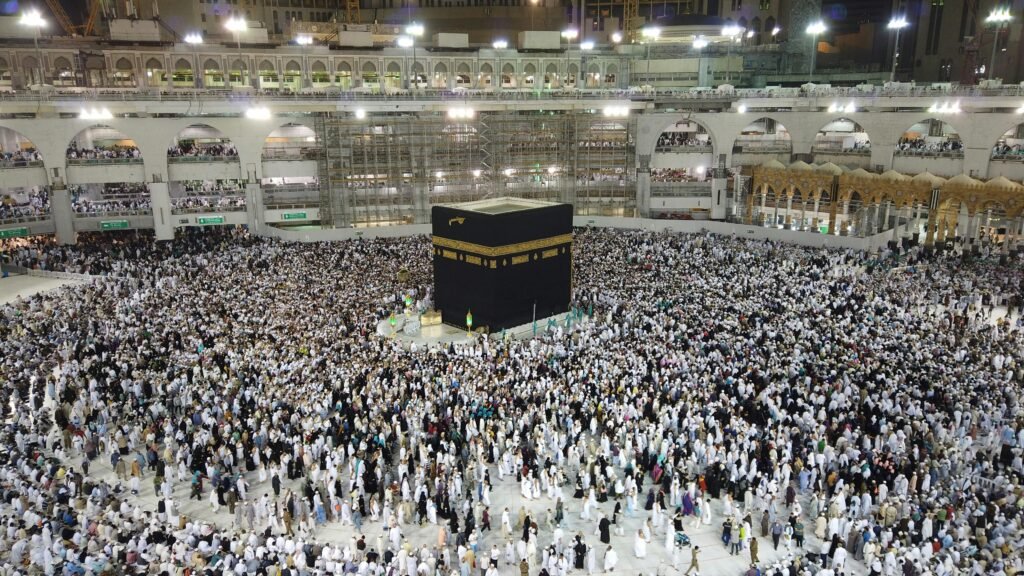Sa’i is an Arabic word. Linguistically, “Sa’i” means walking or following. However, in the Islamic context, Sa’i refers to walking between the two hills of Safa and Marwah seven times, which can be understood as seven laps. Sa’i is essentially a compulsory ritual in Hajj or Umrah, and it must be done after performing Tawaf. Without Sa’i, one’s Hajj or Umrah will not be complete. Sa’i is obligatory for completing the rites of Hajj or Umrah.
History of Sa’i
Prophet Ibrahim (Abraham) (peace be upon him) had no children. When he was 90 years old, he prayed to Allah, asking for a righteous child. Allah accepted his prayer, and eventually, he was blessed with a son named Ismail.
Afterward, Allah tested Prophet Ibrahim (peace be upon him) by instructing him to leave his wife, Hajarah (Hagar) (peace be upon her), and his infant son, Ismail (peace be upon him), with a small amount of food and water in the barren desert near the Kaaba, between the hills of Safa and Marwah. Ibrahim (peace be upon him) followed Allah’s command.
When the food and water ran out, Hajarah (peace be upon her) went in search of water for her son, Ismail (peace be upon him). She climbed to the top of Safa Hill and, finding no water, ran to Marwah Hill. She ran back and forth between the two hills because she could not see her son from where she stood.
Hajarah (peace be upon her) repeated this act of walking between Safa and Marwah seven times, which became very pleasing to Allah. As a result, Allah ordained this act as a significant ritual for Muslims during Hajj and Umrah, making it obligatory.
For this reason, during Hajj and Umrah, men walk between the valleys of the hills, which is marked by green lights. However, women are not required to run, as Allah exempted them from this due to Hajarah’s (peace be upon her) effort and honor.
After Hajarah’s (peace be upon her) seventh walk, she returned to her son and saw water gushing from the earth beneath his feet. In an attempt to contain the water, she placed stones around it and said “Zamzam,” urging it to stop. This well became known as the Zamzam Well, and its water is believed to be blessed, containing healing properties for all ailments.
Allah made Hajarah’s (peace be upon her) act a symbol of faith, and as a result, Sa’i was established as a necessary part of Hajj and Umrah.
How to Perform Sa’i
Sa’i is recommended immediately after Tawaf. However, if you feel exhausted, you can take a short break. Make sure to prepare well for Sa’i, as it involves walking a distance of around three kilometers.
Purity
It is not a requirement to perform Wudu (ablution) before performing Sa’i, but it is recommended to do so. However, it is permissible to perform Sa’i without Wudu if necessary. Women can perform Sa’i even if they are menstruating or experiencing postnatal bleeding.
Intention
Hajar al asawad Istiqlam
Before beginning Sa’i, it is recommended to make Istiqlam by returning to the Black Stone. After completing the Tawaf, make Istiqlam on the ninth round. This is applicable if you perform Sa’i immediately after Tawaf.
If you forget to make Istiqlam or cannot do so due to crowds or fatigue, it can be omitted. However, it is still allowed to perform it from inside the Masjid al-Haram, as long as you are facing the Black Stone.
Istiqlam is performed in the same manner as during Tawaf.
Start your Sa’i from Safa Hill and end at Marwah Hill.
How to Walk During Sa’i
From Lap No.
1 Safa to Marwa
2 Marwa to Safa
3 Safa to Marwa
4 Marwa to Safa
5 Safa to Marwa
6 Marwa to Safa
7 Safa to Marwa
Your Sai will start from Mount Safa and end at Mount Marwa.
Covering the Entire Distance Between Safa and Marwah
The distance between Safa and Marwah must be completely covered. The total distance is 450 meters (1,480 feet), and the seven laps total approximately 3.15 kilometers (1.96 miles). If any part of this distance is left uncovered, Sa’i will be incomplete.
Heading Towards Safa
There is a marker indicating the location of Safa, within the Masjid al-Haram. As you approach Safa, it is recommended to say the following:
إِنَّ الصَّفَا وَالْمَرْوَةَ مِنْ شَعَائِرِ الله ❁
“Inna as-Safa wal-Marwata min sha’a’irillah.”
Indeed, Safa and Marwah are among the symbols of Allah.[Surah Al-Baqarah, 2:158]
Then say this supplication:
أَبْدَأُ بِمَا بَدَأَ اللهُ بِهِ ❁
“Abda’u bima bada’ Allahu bihi.”
I begin with what Allah has begun.
This supplication should be recited once before starting Sa’i and not at the beginning of each lap.
Supplication at Safa
Upon reaching the Safa hill, face the Kaaba and raise your hands to pray. Do not raise your hands or point towards the Kaaba as you would during Tawaf. You may say Takbir (Allah is the Greatest), Tahleel (There is no deity but Allah), and send blessings upon the Prophet Muhammad (peace be upon him).
The following supplication is recommended:
اللّٰهُ أَكْبَرُ ❁ اللّٰهُ أَكْبَرُ ❁ اللّٰهُ أَكْبَرُ ❁ وَلِلّٰهِ الْحَمْدُ ❁
“Allahu Akbar, Allahu Akbar, Allahu Akbar, wa Lillahi al-Hamd.”
Allah is the Greatest, Allah is the Greatest, Allah is the Greatest, and to Allah belongs all praise.
لَا إِلَٰهَ إِلَّا اللّٰهُ وَحْدَهُ لَا شَرِيكَ لَهُ ❁ لَهُ الْمُلْكُ وَلَهُ الْحَمْدُ ❁ يُحْيِي وَيُمِيتُ ❁ وَهُوَ عَلَى كَيْرٌ
“La ilaha illallah wahdahu la sharika lahu, lahu al-mulku wa lahu al-hamdu, yuhyi wa yumitu, wa huwa ‘ala kulli shayin qadir.”
There is no deity but Allah alone, with no partner. To Him belongs the dominion, and to Him belongs all praise. He gives life and causes death, and He is capable of all things.
لَا إِلَٰهَ إِلَّا اللّٰهُ وَحْدَهُ ❁ أَنْجَزَ وَعْدَهُ وَنَصَرَ عَبْدَهُ وَهَزَمَ اَلْأَحْزَابَ وَحْدَهُ ❁
“La ilaha illallah wahdahu, anjaza wahdahu wa nasara abduhu wa hazamal-ahzaba wahdah.”
There is no deity but Allah alone. He fulfilled His promise, supported His servant, and defeated the confederates alone.
After reciting these supplications, you can pray for yourself and make any other supplications as desired. The supplications should be repeated three times, and in between, make personal prayers as was the practice of the Prophet (peace be upon him).
Proceed Towards Marwah
Green Light
When traveling from Safa to Marwa, you will encounter two green fluorescent lights, which mark the spots where Hajarah (peace be upon her) ran to the elevated parts of the hill. Men are encouraged to walk briskly between these two markers (called Al-Akhdayrayn), while women should walk at a normal pace.
The green lights mark the place where Hajarah ran on the elevated parts of the hills.
At Marwah, Make a Supplication
Upon reaching Marwah Hill, face the Kaaba, raise your hands, and recite the same supplications you said at Safa.
This completes one lap of Sa’i. Returning to Safa counts as the second lap.
End of Sa’i
Repeat this process until you have completed seven laps, at which point you should be at Marwah Hill.
Signs of Completion of Sa’i
Supplication and Salah
After completing the Sa’i, offer a two-Rakat Nafl prayer at Masjid al-Haram.
Leaving the Haram
When leaving Masjid al-Haram, exit with your left foot and say the following supplication, as was the practice of the Prophet (peace be upon him):
بِسْمِ اللهِ وَالصَّلَاةُ وَالسَّلَّامُ عَلَى رَسُولِ اللهِ ❁ اللّٰهُمَّ إِنِّي أَسْأَلُكَ مِنْ فَضْلِكَ ❁
“Bismillah wa-s-shalatu wa-s-salamu ‘ala Rasulillah. Allahumma inni as aluka min fadlik.”
In the name of Allah, and peace and blessings upon
the Messenger of Allah. O Allah, I ask You for Your bounty.
After Sa’i
If you perform Umrah outside of the Hajj season or perform Umrah as part of Hajj al-Tamattu, you will shave or cut your hair after Sa’i, which will allow you to remove your Ihram. This marks the completion of your Umrah. However, if you are performing Hajj al-Qiran, you will not cut your hair, and you will remain in Ihram until Yawm al-Nahr.
Rules for Sa’i
Make the intention for Sa’i.
Perform WuduPerform Sa’i yourself.
Put on Ihram before performing Sa’i for Hajj.
Put on Ihram before performing Sa’i for Umrah.
Perform Sa’i at the correct time.
Start Sa’i from Safa and finish at Marwah.
Perform Sa’i after TawafPerform Sa’i on foot unless there is a valid excuse.
Complete seven laps.
Remain in Ihram until the Sa’i of Umrah is completed.
Cover the full distance between Safa and Marwah.
Make Istilam before going to Safa for Sa’i.
Remain free from major impurityKeep the awrah covered.
Face the Kaaba at Safa and Marwah.
Perform Sa’i continuously without breaks or take breaks in between.
If you are a man, walk briskly between the two green markers (Al-Akhdayrayn).
Recommended Actions (Mustahabbat)Make long supplications three times at Safa and Marwah.
Perform two rak’ahs of Nafl prayer after completing Sa’i.



